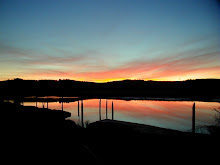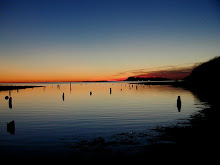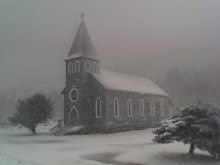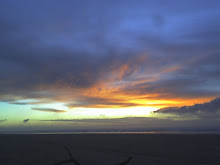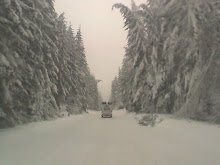 Sustainable Table
Sustainable TableFriday, February 27, 2009
Sustainable Table
 Sustainable Table
Sustainable TableThursday, February 26, 2009
Dune Grass III
So..what will be the dune of the future? In our lifetime, as in the next 30-40 years, the dune system that we grew up with, that we all know and love, will likely become a mere shadow of its former self as it is slowly compressed into a narrow strip between the westerly advance of the Sitka Spruce/Beach Pine forest and the easterly advance of the Pacific Ocean.
The forest advances into new territory (created in the last 90 years) and the beach is no longer accreting fast enough to create new dune as we know it and it is far more likely that mean sea level rise will claim land back. Why is the sea rising? Well, for that last 7000+ years the sea has risen 120-200 feet as North America came out of the Ice Age. It more recent times, thermal mass exapansion of ocean water as well as continued ice melting will likely accelerate the trend.
What that means for Seaviewites, Long Beachians, Ocean Parkians and Surfsideians is that we'll have a much narrower dune grass environment. Those of you that doubt the rapidity of change..please recall that in my father's lifetime of 88 years, the beach accreted into its current state so in my lifetime it could certainly go the other way.
If you want a peak at what the future might hold..drive up to Leadbetter Point State Park and Wildlife Refuge and walk the beach along Willapa Bay and you will see a Sitka Spruce forest right up against an eroding beach. The one difference with the ocean side is that the wind driven salt spray and sand (with salt) will likely create a very tough zone for some plants and that might be wider, say 20-50 feet and more typical of what you might find along static beaches on the West Coast of Vancouver Island. Just south of Tofino is a beach..Long Beach of all things, and it has a very narrow grassy area that clearly ebbs and flows with winter storms pulling sand away and summer winds driving sand back up. That might be our beach of the future.
Embrace change..its whats happening.
Tuesday, February 10, 2009
Why the name "My Seaview"?
Simple. About 8 years ago Dian and I were at Monticello and Kat Imhoff escorted us around a bit. There is a spot just east of Jefferson's home and above the garden that Jefferson called "My Seaview". From that point looking east north east, the blue cast Piedmont hills look like waves of a sea and as Jefferson had crossed the Atlantic, he clearly remembered what it was like to look off at the distant sea from the deck of a sailing craft. Kat implied that he liked to gaze off at his Seaview, possibly in reflection.
I marveled at the thought that a continent away, I too gaze west at the waves of the Pacific wondering what mystery they hold.
Thursday, February 5, 2009
Port of Peninsula and Pile Driver
Port of Peninsula, Pile Driver and Oyster Picking
Click Twice on the lower left arrow button to start the video.
Dad and I were down at the Nahcotta dock a month ago and here's Bergerson's crawler crane using a crawler crane mounted diesel engine pile driver to set steel piles for the new Port of Peninsula dock. The hammer is essentially a 2-stroke diesel engine in which the piston is also the driving hammer. You can't really see the action within the steel cage held aloft by the crane, but there is a massive single cylinder engine up there and once the crew lights her off, a lot of force is generated and it is quite loud. See this great website for a history on pile drivers http://www.vulcanhammer.info/.
These galvanized steel piles are pounded in what are called "bents" or rows of piles. Then steel i-beams are laid atop the piles and welded in place, subdecking/framing is put on the i-beams and a concrete deck is poured atop.
The piles in the video are at put in at an angle and welded to the verticle piles to stabilize the dock and they are called "brace piles" or "batter piles". The new dock replaces the old wooden dock originally put in about 1958 or so. It was on it's last legs so to speak. The port is home to over a dozen oyster dredges and many of the oysters are transferred over the dock to large trucks. When a truck backed up on the old dock and hit the air brakes, you could feel the dock shudder and sway. Docks are easily destroyed by marine vessels hitting them and here is why. A bigger boat/ship/ferry etc can way many tons and as they glide through the water, they've got a lot of motion behind that weight. This is why when a ferry's electrical switching system fails as the captain asks for full reverse...a ferry dock can be destroyed in a matter of seconds. All that weight in motion meets the dock and crunch goes the dock. This is why docks have massive fender piles and bumper piles to asorb the shock of a ship tenderly bumping it.
The new dock is bigger, stronger, and can accommodate the bigger trucks that haul more oysters that are delivered to the dock by bigger dredges. 40 years ago, nearly all (except the Robert M) dredges were wood. Today..wood dredges are in the minority. Wiegardt's "Leader" and "Tidepoint" are examples of the older wood dredges. "Tide Point" was built in at the Ilwaco Boat Works half a century ago. New dredges are metal and either steel (Hawk's Point) or marine grade aluminum (Northern for example). Just as the dredges evolved..so has the dock.
I worked on the Leader for a bit one summer, shoveling oyster shell off and then picking up tubs. Sam Slagle ran it and we all called it the "Leaner" for its pronounced lean to starboard as I recall. I also had an opportunity to be on the Tidepoint a few times. I recall that Ed Houston was the boat captain at the time and when he retired, Ernie Sadewasser was the boat captain. One time Dave Wiegardt and I were sitting on the top of the wheel house watching Bob Hunt and Allen Ray Allen pick up tubs. Ernie laid on the air horn just for fun and Dave and I just about jumped off the dredge.
Ed Houston was the bed foreman and his picking crew would go out and pick tubs in a line, Ed was very particular about lining up the tubs and carefully coiling the rope and wooden floats on top of full tubs because when the tide came in, the dredge would sidle up to the row of wooden floats floating up from the tubs and began to hoist them one by one and dump them on deck.
A bunch of us kids from the area where also in Scouts and we wanted to go the International Jamboree in Japan in '71. Dobie and Lee Wiegardt agreed to hire us on as oyster pickers so that we could raise money. Of course, we are 15 year old kids out there picking oysters with men in their 30's and 40's who have been picking most their life. Brutal work.
Ed made sure that the working man got the best ground to pick and in a tide I recall that the best pickers could bring in 240 bushels or 10-12 tubs. Us kids could barely do 1/3 of that, around 4 tubs or 80-100 bushels. At 17 cents per bushel that would be $17 U.S. per tide for us and nearly nearly 3 times that for an adult. Very hard work often defined as "assholes and elbows".
One time we were picking and Ed walks over to me and says "I see your dad's coming over". I glance up (not wanting to stand up and look around) and I see this figure about a mile off and I say "how you know it's him?". Ed laughed and said "I've been watching your father walk across the flats for 25 years and I can tell who it is just by his walk".
Once the tide came in, Ed ran the Tidepoint out to the tubs. The headman on deck called the "cowboy" threw a loop of chain into the water and around the floating wooden block. Then the boat captain would instantly winch the tub (which was full of water, mud, oysters) up, and as the tub cleared the bay, water would pour out the side strakes of the tub and he'd swing the tub on deck where the deckhand would attach a metal hook to the bottom of the tub and then the tub would be winched upside down and the oysters dumped out. The boat captain was a busy man running two winches, the main engine, the wheel, and keeping and eye out for the line of tubs.
Picking oysters was and is very hard work and tough on the body. Typically you are wearing heavy hip boots and walking in mud trying to pack a wire bushel basket filled with oysters and dump it in a tub that might be 20-50 feet away from you. In the old days, one could always get a job picking oysters but working the tides was a pain because your got up 45 minutes later every day to match the tide and your body tended to never sync with the time.
Sunday, February 1, 2009
Beach Clean Up
 Beach Clean Up!
Beach Clean Up!On Saturday morning, a most beautiful morning with temps in the 30's, 7 of us charged towards Benson Beach to make our contribution to the Grass Roots Garbage Gang's most noble and long-lived efforts to keep the beachs clean. This is no easy feat as whatever floats..ends up on the beach and that is not good. If you live near a stream, river or bay, if you work on a boat..please keep your trash nailed down..otherwise it floats away and we will find it. Please contact the GRGG's at their website(http://www.ourbeach.org/index.html) if you enjoy the beach and want to keep it clean.
Several of us are board members of the Friends of the Columbia River Gateway and we were very pleased to dedicate a modest amount of money and our time to assist in keeping one of our key resources clean.
We started at about 9. One team of three started at the North Jetty and the other team of four started at the base of North Head. We walked abreast and picked up literally every piece of junk we came across and finished the 1.8 mile long beach about 3 hours later.
Our efforts resulted in bagging (43 bags plus the unbaggable stuff) about 1000 pounds of trash including rope, a shopping cart, 5 tires, shoes, shotgun shell wadding, and miscellaneous plastic trash. Some items were small like plastic bottle tops, shotgun shell wadding and short lengths of rope. We found very few glass objects (only one light bulb and one fluorescent bulb) and as noted in other trash surveys..most of the trash is plastic. For the starving our finds included a quart of milk only 6 days old, a bottle of beer and an onion. If this was Lost!..well we'd have indigestion.
The weather was cold but very nice. A Bald Eagle watched us meander up the beach. Betsy's picker upper broke and she learned the hard way how painful it is to reach over and snag those small plastic things.
The State Parks crew cruised the beach as we finished up and picked up our bags of trash and stacks of junk. A few items had to be left including part of a lifeboat and rope ends that couldn't be dug out of the ground and a crab pot buried so deep it just might stay there a while. Most of the rope was cut off above ground and that is a chore as well. I'd recommend a machete for chopping rope out of wood and kelp piles.
As many high tide waves wash over the dunes at Benson, there are several areas behind the dunes that likely accumulate trash and addressing them is for another day. I and others think that we really needed 10 people to do an adequate job that would include the area behind the dune.
Hats off and we salute the Grass Roots Garbage Gang for their dedication in keeping one of our prize resources free of trash. Unfortunately..this is an ongoing battle waged three times a year.
Followers
About Me

- Jim
- Seaview, Washington, United States
- I live a mile from where I was born but sometimes I feel like a stranger in my own strange land. Descendant from gold miners (The Yukon and Mexico), coal miners (Wales, British Columbia and Washington), timbermen (Sweden), sod and berry farmers (Missouri, Washington), Klondikers, fortune seekers and just plain hearty peasant stock.
